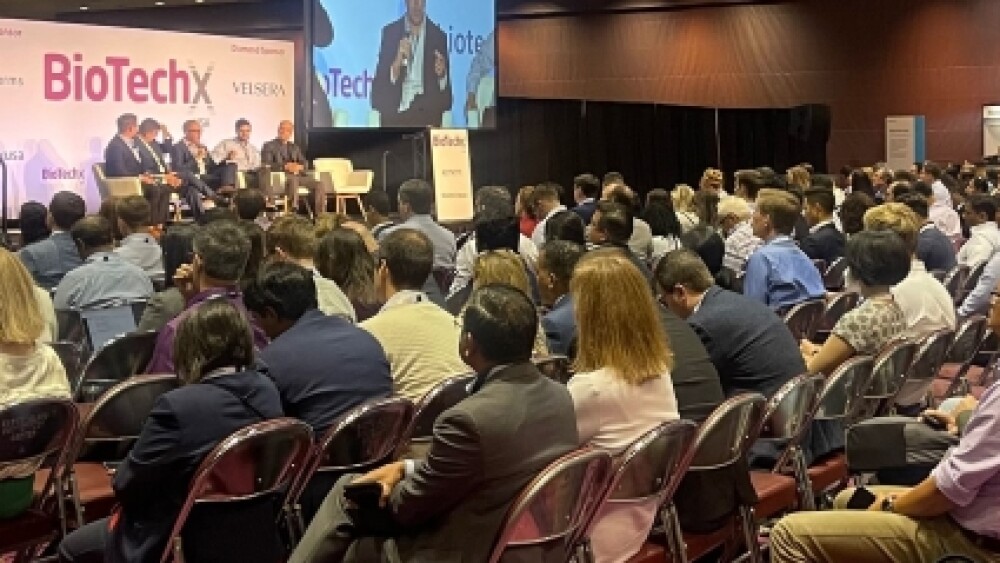The first annual BioTechX USA, held in Santa Clara in September, bridged the communication gap by bringing together life sciences leaders in all areas of the industry.
In an era where the life sciences industry is experiencing a rapid digital transformation, the first annual BioTechX USA, held in Santa Clara in September, bridged the communication gap by bringing together life sciences leaders in all areas to discuss the challenges of today and the potential opportunities for tomorrow.
With ten available tracks spanning four programs that included speakers from academia, regulatory agencies, venture capital firms and large pharma, BioTechX USA announced its arrival in the United States with an impressive lineup.
“The conference encourages attendance by people representing a range of people from different audiences,” stated Eloise Smith, BioTechX USA’s conference producer at Terrapinn, “to hopefully allow people to cross paths that might not otherwise. At Terrapinn, we believe that we need to bring these people together to help standardization across the life sciences industry, increase collaboration and the exploration of ideas. . . . This is why we try and get people from a range of different audiences.”
Combining Industries In Europe and the USA
The conference is designed to be the sister conference to BioTechX Europe, the largest congress bridging the gap between technology and life sciences for eight years. While Terrapinn produces many conferences spanning different industries, BioTechX USA and BioTechX Europe are the only conferences combining two industries.
“We have been planning to break into the U.S. space because we felt it was needed,” stated Anna Abiola, BioTechX USA’s conference producer at Terrapinn. She further explained that the conference is divided into four components: the bio-data track, which includes bioinformatics, digital transformation and real-world evidence and data; a genomic track, which includes rare disease in genomics, precision medicine and liquid biopsy; a pharma artificial intelligence (AI) track; and a cheminformatics track. BioTechX USA is split into these different tracks instead of focusing on just one area because the different tracks interlink. Because of the different focus areas, the conference blends technology and life sciences.
Communication for the Future of Digital Health
Based on attendees’ responses, organizers say this type of conference is exactly what was needed to foster increased collaboration and communication throughout the industry. Opening the conference, Christina Waters, president and CEO of Rare Science, expressed her excitement to delve into some of the biggest topics the industry is facing to change the future of healthcare: data sharing, AI genomics, patient centricity, new therapeutic models, clinical approaches and the future of global health.
The keynote opening remarks, given by Anna Sandler, global and U.S. head of digital health marketing at Teva Pharmaceuticals, focused on the future of digital health and using technology to improve upon traditional approaches of patient care. She explained that if applied properly and designed simply, the digital therapeutic model is the smart approach. This model is different from the old infrastructures, processes and standard of care of the past, so simplicity and user-friendly design are musts.
The conference’s discussion panelists represented a range of entities: Pfizer, Roche, Harvard Medical School, National Institutes of Health (NIH), Endeavor Venture Funds, Bessemer Venture Partners and the Alliance for Artificial Intelligence in Healthcare (AAIH).
Understanding the Need for Pristine Data and Human Behaviors
Reoccurring themes included data accuracy, bias, transparency and ethical data use and collection. These led to discussion points such as one brought up by David Apfel, head of data science external innovation at Janssen Pharmaceutical Inc. , who stated that we need to understand not only how these tools work but how people interact with the tools. While AI is designed to make our jobs easier and make us better, there are some cases where it can easily make us worse. To illustrate the point, the panel discussed ChatGPT and took a poll of the audience regarding how many have used it to create an email and then how many did not read the email or only did a precursory review of it before hitting send. A simple but effective illustration of how humans may begin to rely too heavily on AI tools throughout the drug development process.
Regarding the future of AI in the life sciences, the industry is looking to technology for more innovative ways to bring treatments to patients—such as utilizing synthetic data and digital twins—while bringing down costs. Panelists on the AAIH panel noted that the number of AI-designed drugs is growing by 40% per year. Coming at the close of the conference, this keynote discussion echoed an overarching theme of the conference: The industry is going through a time of widespread collaboration, from academia, membership organizations, pharma, and technology companies to venture capitalists, and this collaboration is critical to its future development.
Abiola and Smith have already started planning for the 2024 BioTechX USA conference, to be held in the northeast. Next year, they plan to replace the cheminformatics track with a gene therapies track to better suit the needs of the U.S. life sciences industry.
Lori Ellis is the head of insights at BioSpace. She analyzes and comments on industry trends for BioSpace and clients. Her current focus is on the ever-evolving impact of technology on the pharmaceutical industry. You can reach her at lori.ellis@biospace.com. Follow her on LinkedIn.






